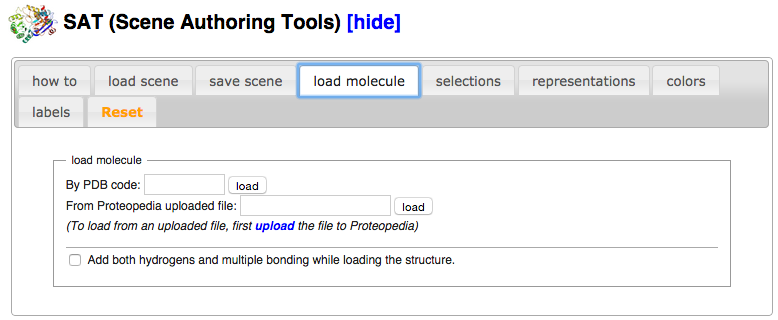User:Shai Biran/Practice Proteopedia tutorial shai5
From Proteopedia
(Difference between revisions)
| Line 13: | Line 13: | ||
#Click on the tab “load molecule” in the Scene Authoring Tools. | #Click on the tab “load molecule” in the Scene Authoring Tools. | ||
#Load the PDB file 1ema by entering the PDB code “1ema” in the input box next to the words “By PDB code:” and then pressing the adjacent button marked “load” | #Load the PDB file 1ema by entering the PDB code “1ema” in the input box next to the words “By PDB code:” and then pressing the adjacent button marked “load” | ||
| - | |||
| - | |||
| - | '''Your page should look like this:''' ↓↓↓↓↓↓↓↓↓↓↓↓ | ||
| - | |||
| - | ==My Practice Page== | ||
| - | <StructureSection load='1ema' size='340' side='right' caption='GFP (PDB entry [[1ema]])' scene=''> | ||
| - | |||
| - | == Introduction == | ||
| - | Green fluorescent protein ('''GFP'''), originally isolated from the jellyfish Aequorea victoria (PDB entry [[1ema]]), fluorsceses green (509nm) when exposed to blue light (395nm and 475nm). It is one of the most important proteins used in biological research because it can be used to tag otherwise invisible gene products of interest and thus observe their existence, location and movement. | ||
| - | |||
| - | == Exploring the Structure == | ||
| - | GFP is a beta barrel protein with 11 beta sheets. It is a 26.9kDa protein made up of 238 amino acids. The | ||
| - | <scene name='Sandbox_4/Green_fp/1'>chromophore</scene>, responsible for the fluorescent properties of the protein, is buried inside the beta barrel as part of the central alpha helix passing through the barrel. The chromophore forms via spontaneous cyclization and oxidation of three residues in the central alpha helix: -Thr65 (or Ser65)-Tyr66-Gly67. This cyclization and oxidation creates the chromophore's five-membered ring via a new bond between the threonine and the glycine residues.<ref>PMID:8703075</ref> | ||
| - | |||
| - | |||
| - | This is a sample scene created with SAT to <scene name="/12/3456/Sample/1">color</scene> by Group, and another to make <scene name="/12/3456/Sample/2">a transparent representation</scene> of the protein. You can make your own scenes on SAT starting from scratch or loading and editing one of these sample scenes. | ||
| - | |||
| - | </StructureSection> | ||
== Next == | == Next == | ||
| - | [[User:Shai Biran/Practice Proteopedia tutorial | + | [[User:Shai Biran/Practice Proteopedia tutorial shai5|Previous page (6)]] |
| - | [[User:Shai Biran/Practice Proteopedia tutorial | + | [[User:Shai Biran/Practice Proteopedia tutorial shai7|Next Page (8)]] |
Revision as of 14:25, 25 February 2015
Adding a GREEN SCENE LINK
- First, let's clean things a bit. Change the heading in your page (where it says 'your heading here'). Feel free to choose any new heading you want.
Delete the two rows starting with 'This is a default text...'
- Now let's change the displayed 3D structure into the structure of GFP. In the row starting with StructureSection load change 1stp to GFP's pdb code. Hint - if you're not sure which pdb code to use, look at the GFP test page. Change the caption as well from caption='Caption for this structure’ to caption='GFP (PDB entry 1ema)'.
use the 'show preview' button to check what changed in your page.
Now that we have our 3D model on the page, let’s create a green scene link that shows 1ema as it looks in the the left part of the 2D image on the GFP Sample page where we got our text. (go back to that page to see what the picture looks like) User:Shai Biran/GFP test page To create a green scene link, we will need to use the 'Protopedia Scene Authoring Tools'.
- After clicking edit this page, scroll down to the bold text that says “Scene authoring tools [show]” next to a colorful molecule. Click on “show” to expand the Scene Authoring Tools.
- Click on the tab “load molecule” in the Scene Authoring Tools.
- Load the PDB file 1ema by entering the PDB code “1ema” in the input box next to the words “By PDB code:” and then pressing the adjacent button marked “load”
Next
Previous page (6)

